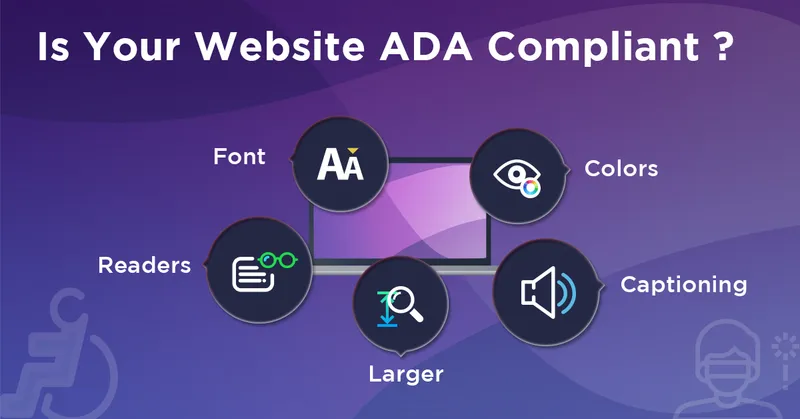

Get Website Development with ADA Compliant
Why your Website should be with the Americans Disabilities Act (ADA) Compliant?

The Americans with Disabilities Act (ADA) progressed toward becoming law in 1990. The reason for the law is to ensure that individuals with inability have indistinguishable rights and openings from every other person.
It gives social freedoms confirmations to individuals with ineptitude like those provided for individuals dependent on race, national reason, shading, sex, age, and religion. It guarantees approach open entryway for individuals with impairments in open lodging, work, transportation, state and close-by citizen-driven associations, and media interchanges.
Establishment & Implementation
In 2008, the Americans with Disabilities Act Amendments Act (ADAAA) was marked into law and wound up powerful on January 1, 2009. The ADA made various noteworthy changes to the meaning of "handicap."
Is Your Website need to meet this policy?
If you are a business that exists to benefit the public, a local or state government agency, or are a private employer with 15 or more employees, you should be compliant with the ADA regulations.
A good rule of thumb to follow is that if your physical location requires ADA compliance, chances are you’ll want to protect yourself by assuming your web presence does as well. Abiding by these regulations creates a fair online experience for all users – disabled or not.
ARE THERE ANY SECONDARY BENEFITS TO MAKING YOUR WEBSITE ADA COMPLIANT?
Not that we are aware of – unless the search engines begin making the algorithms pick up that as a ranking benefit. That doesn’t appear to be on their horizon as far as we know at the time of this writing.
What we DO KNOW is that some older browsers and devices may actually have some difficulty with displays some websites where all of the suggested META and SCRIPT TAGS are concerned.
Now a final question comes to your mind, WHAT HAS TO BE DONE ON A WEBSITE TO MAKE IT ADA COMPLIANT?
Sound scary? It’s not as bad as it seems. Your site probably already meets many of these rules and others will only take our web developers a few minutes (PER PAGE) to bring up to par. The larger the website, the longer it takes, the more it costs.
1. Provide Alternatives
-> Alt Text: Add alt text to all meaningful images on your website.
-> Text Transcripts: Add a text transcript beneath all video-only and audio-only files.
-> Closed Captioning: All videos on your website must have closed captioning.
-> No Images of Text: All text must be readable by a screen reader.
2. Videos
-> Videos are embedded with caption and subtitles for the people with disabilities like hearing disability.
3. Keyboard
-> Some people can't able to access the whole webpage with the mouse, it is good practice to give keyboard shortcuts for navigation purpose.
4. No Automatic Content
-> No Pop-Ups: Any distracters that activate on your website without being prompted by the user must be removed.
-> Static Website Forms: Forms must be fully controllable by the user.
5. Keyboard Accessible
-> Your website must be fully accessible without a mouse, by using the arrow or tab buttons.
6. Intuitive Website
-> Language and Title Tags: Set a language for your website and provide clear titles for each page.
-> Skip to Content: Users must be able to skip to the heart of your content.
-> Consistent Navigation and Flow: Your overall website and each page needs to be predictable and logical
-> Descriptive Links and Headers: Be obvious in linking to or setting up content so that users know what to expect. In other words, be very obvious in wording your headers, and anchor text/text surrounding your links
-> Labeled Elements: Put a label on each important element of your website.
-> Multiple Ways to Access Content: Provide multiple ways to navigate through your website.
-> Clear Forms: Make forms simple and easy to fill out.
-> Clean Code: Your website must be coded properly and free of errors.
7. Font Size, Headers, Labels
-> Some people with visibility problem can't able to see small fonts. So it is necessary to make legible fonts, headers and labels with decent size for better visibility.
8. Only Necessary Time Limits
-> There should be no time constraints on website access unless absolutely necessary.
The overriding concern courts have in deciding ADA website compliance cases is whether a website is accessible to those with disabilities.
WHAT HAPPENS IF YOU DON’T DO ANYTHING?
--> By not having an ADA Compliant Website, you would probably miss out on getting that business from such a disabled person who would just search elsewhere until they found a website that worked best for them.
--> We could see a scenario in the future where Google, Yahoo, and other search engines only ranked websites that were ADA compliant. They have recently moved in that direction to “force” businesses to make their websites Mobile Friendly or lose rankings altogether. So it is not without some realm of possibility that they could do the same with this.
WHAT ARE THE COSTS TO MAKING MY WEBSITE ADA COMPLIANT?
Some unscrupulous web design firms would have you believe in two things.
First, there is NO simple tool that you can run on your website to make it ADA Compliant. Much more has to be done PER PAGE to accommodate the steps necessary. So PRICING depends on how big your website is.
Wrapping Up
By making your company’s website, mobile apps, and documents ADA compliant, you are now universally accessible to everyone and will be more visible to Google searches. There’s significant growth in ADA Title III lawsuits over websites. a known Website Development Company will assist you for all necessary lawsuits to make your Website ADA Compliant.






